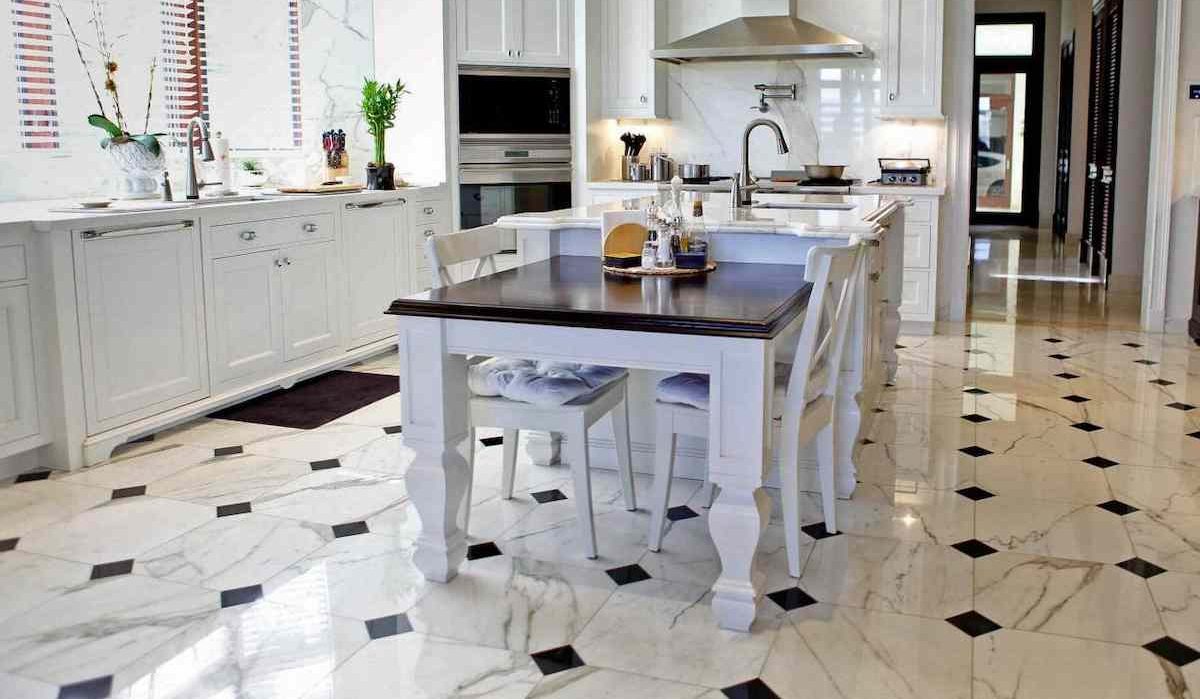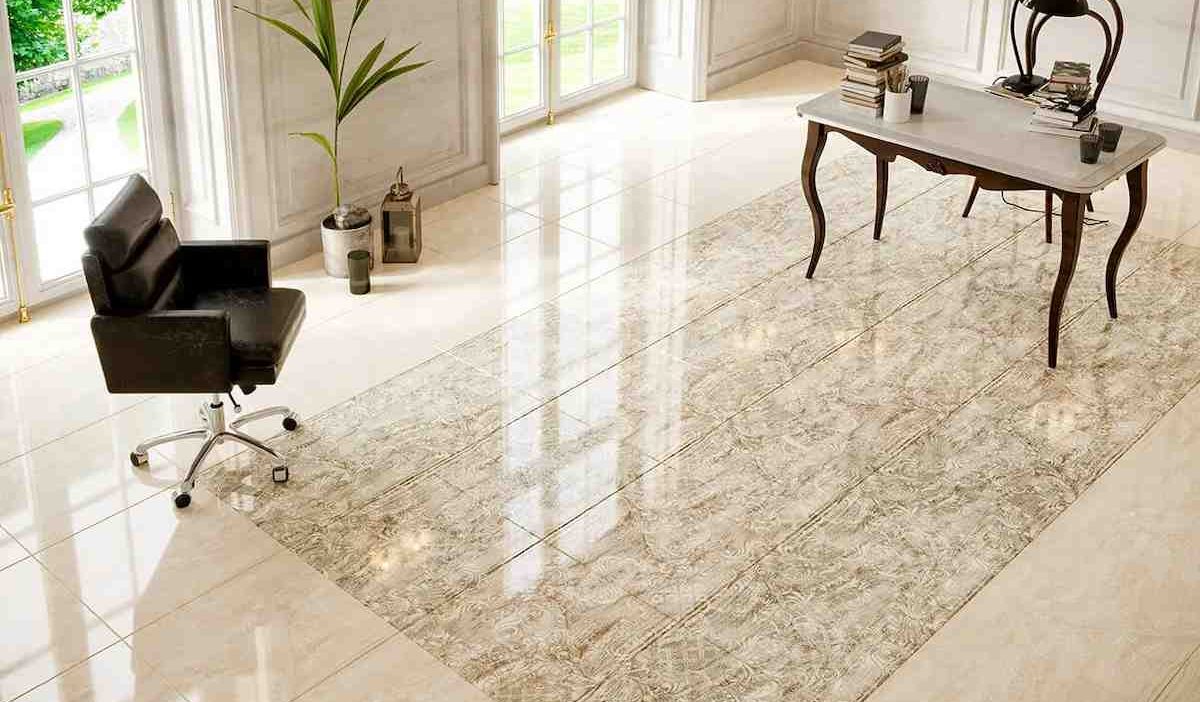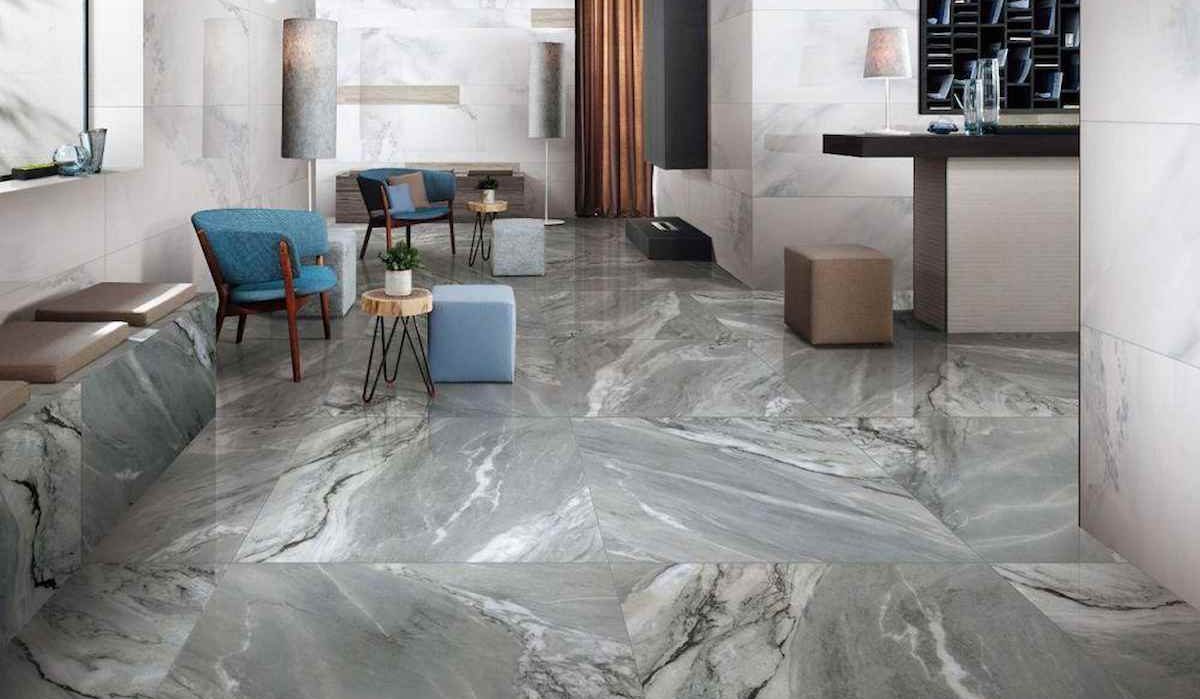A tile made of marble is considered to be one of the most luxurious options available for flooring in a kitchen. It is completely natural and is obtained from the interior of mountains in the form of large slabs of stone. These slabs are subsequently honed and refined into the individual tiles, slabs, and mosaic sheets that are used in the standard construction processes. These processes include the installation of floor and wall tiles as well as countertop slabs. Marble flooring has traditionally been associated with a feeling of wealth and opulence due to its luxurious appearance. It is a material that has been used in some of the greatest works of art and architecture ever produced by humankind, and it has been seen adorning the palaces of kings and queens throughout the course of human history. It is possible for it to create a sense of sophistication when it is installed in a kitchen, which will carry over into the atmosphere of the entire room. Marble flooring that has been polished has a very low coefficient of friction, which means that it may pose a risk of slipping and falling if it is not properly maintained. This is especially important to remember a kitchen which is prone to accidental spills of water and other liquids. The use of floor mats is one approach that can be taken to mitigate this issue to some degree.  Advantages of Having Marble Floors in One's Kitchen The use of marble as a flooring material in kitchens comes with a number of important benefits, including the following: Unique color and pattern: There is a wide range of color options available for marble tiles and slabs; however, due to the nature of the quarrying and manufacturing processes, each individual piece of marble will have its own unique coloration and veining. Although tiles made from the same large slabs will have an overall uniformity of color and similarity of pattern, no two marble floors will ever look exactly the same. Tiles made from the same large slabs will have an overall uniformity of color. One of the primary factors that contribute to marble's high value as a construction material is the fact that each marble floor has its own distinct appearance. Polish: Marble, in contrast to many other types of stone used for flooring, can withstand having an exceptionally high polish applied to it. Because of this, producers are able to polish the surface of the marble to make it incredibly smooth and shining, which results in a product that is highly appealing. The polishing process has the additional effect of bringing out the natural hues in the stone, letting them stand out more and seem more striking.
Advantages of Having Marble Floors in One's Kitchen The use of marble as a flooring material in kitchens comes with a number of important benefits, including the following: Unique color and pattern: There is a wide range of color options available for marble tiles and slabs; however, due to the nature of the quarrying and manufacturing processes, each individual piece of marble will have its own unique coloration and veining. Although tiles made from the same large slabs will have an overall uniformity of color and similarity of pattern, no two marble floors will ever look exactly the same. Tiles made from the same large slabs will have an overall uniformity of color. One of the primary factors that contribute to marble's high value as a construction material is the fact that each marble floor has its own distinct appearance. Polish: Marble, in contrast to many other types of stone used for flooring, can withstand having an exceptionally high polish applied to it. Because of this, producers are able to polish the surface of the marble to make it incredibly smooth and shining, which results in a product that is highly appealing. The polishing process has the additional effect of bringing out the natural hues in the stone, letting them stand out more and seem more striking.  One of the reasons why marble has been utilized in such a significant number of outstanding works of sculpture is because it has a characteristic that is somewhat transparent and allows some light through. This property permits light to permeate the surface of some lighter-colored marble materials when they are used for flooring, which gives the material a subtle glow when the light is shining on it. Even with marbles with a darker background, the way light interacts with the surface of the stone may be extremely beautiful. Marble is an all-natural substance that is formed in the ground and is considered to be one of the most precious stones. Those individuals who value natural materials more than synthetic ones are likely to enjoy this trait. Although marble cannot be considered biodegradable, it is a natural material that can be recycled and does not contribute to the degradation of the environment after its useful life has come to an end. Cons of Having Marble Floors in the Kitchen Marble is one of the more expensive and high-priced kitchen flooring materials available on the market today.
One of the reasons why marble has been utilized in such a significant number of outstanding works of sculpture is because it has a characteristic that is somewhat transparent and allows some light through. This property permits light to permeate the surface of some lighter-colored marble materials when they are used for flooring, which gives the material a subtle glow when the light is shining on it. Even with marbles with a darker background, the way light interacts with the surface of the stone may be extremely beautiful. Marble is an all-natural substance that is formed in the ground and is considered to be one of the most precious stones. Those individuals who value natural materials more than synthetic ones are likely to enjoy this trait. Although marble cannot be considered biodegradable, it is a natural material that can be recycled and does not contribute to the degradation of the environment after its useful life has come to an end. Cons of Having Marble Floors in the Kitchen Marble is one of the more expensive and high-priced kitchen flooring materials available on the market today.  The price of individual marble tiles measuring 12 inches by 12 inches can range anywhere from $5 to $10 per square foot. It is possible for the price to be even higher when dealing with designer mosaics, larger tiles, slabs, and non-standard sizes. Marble is quite a soft stone, and polished marble tile is relatively easy to scratch because of this. It is possible to scratch marble. Moving furniture or even having animals walk across a marble floor over time can leave scratches and other marks on the surface of the stone. Repairing a marble tile that has been scratched is a difficult task that, in most cases, requires the assistance of a professional who can repolish the tile. Marble is rather porous, and it has a somewhat alkaline composition, which means that anytime an acidic material interacts with it, a chemical reaction will occur in the form of a very apparent stain. Because of these characteristics, marble is susceptible to being stained.
The price of individual marble tiles measuring 12 inches by 12 inches can range anywhere from $5 to $10 per square foot. It is possible for the price to be even higher when dealing with designer mosaics, larger tiles, slabs, and non-standard sizes. Marble is quite a soft stone, and polished marble tile is relatively easy to scratch because of this. It is possible to scratch marble. Moving furniture or even having animals walk across a marble floor over time can leave scratches and other marks on the surface of the stone. Repairing a marble tile that has been scratched is a difficult task that, in most cases, requires the assistance of a professional who can repolish the tile. Marble is rather porous, and it has a somewhat alkaline composition, which means that anytime an acidic material interacts with it, a chemical reaction will occur in the form of a very apparent stain. Because of these characteristics, marble is susceptible to being stained.  Acidic liquids lke sauces and fruit juices, which have the potential to splash or spill onto a marble kitchen floor, have the potential to leave a permanent stain on the surface of the marble and cause it to lose its luster. This can happen if the acidic liquids are allowed to sit on the marble for an extended period of time. Difficult and time-consuming upkeep: A marble kitchen floor will need to be properly sealed using a surface-barrier sealing chemical that the manufacturer suggests preventing stains from appearing on the surface. This produces an invisible covering over the marble, which shields it from substances that may discolor it and acidic substances. In order to keep the tiles looking their best, you will need to reapply this sealant to the marble floor regularly, somewhere between once every six months and once every year. Expensive and difficult to find a suitable replacement for Marble tile has a high price tag and can be difficult to remove once it has been installed. If you maintain your marble kitchen floor properly, it should last for many years.
Acidic liquids lke sauces and fruit juices, which have the potential to splash or spill onto a marble kitchen floor, have the potential to leave a permanent stain on the surface of the marble and cause it to lose its luster. This can happen if the acidic liquids are allowed to sit on the marble for an extended period of time. Difficult and time-consuming upkeep: A marble kitchen floor will need to be properly sealed using a surface-barrier sealing chemical that the manufacturer suggests preventing stains from appearing on the surface. This produces an invisible covering over the marble, which shields it from substances that may discolor it and acidic substances. In order to keep the tiles looking their best, you will need to reapply this sealant to the marble floor regularly, somewhere between once every six months and once every year. Expensive and difficult to find a suitable replacement for Marble tile has a high price tag and can be difficult to remove once it has been installed. If you maintain your marble kitchen floor properly, it should last for many years.  However, if the time comes when you need to replace it, you may find that it is simpler to install a new floor directly over the marble than it is to try to remove the marble and then install the new floor. Marble flooring, similar to ceramic tile flooring, is an inherently cold construction material. If the marble floor does not have some kind of radiant heating system integrated into it, the sensation that one gets when walking on it in cooler climates can be a little bit unsettling. Marble floors are extremely hard, which means that if a fragile object were to fall onto them, it would immediately shatter into a million pieces. Or, even more horrifyingly, the marble tile itself could crack. Concerns about the environment Although marble is a completely natural product; environmental purists point out that using mining equipment and quarrying saws results in carbon dioxide emissions and that the transportation of these heavy materials over long distances overseas results in high consumption of fossil fuels.
However, if the time comes when you need to replace it, you may find that it is simpler to install a new floor directly over the marble than it is to try to remove the marble and then install the new floor. Marble flooring, similar to ceramic tile flooring, is an inherently cold construction material. If the marble floor does not have some kind of radiant heating system integrated into it, the sensation that one gets when walking on it in cooler climates can be a little bit unsettling. Marble floors are extremely hard, which means that if a fragile object were to fall onto them, it would immediately shatter into a million pieces. Or, even more horrifyingly, the marble tile itself could crack. Concerns about the environment Although marble is a completely natural product; environmental purists point out that using mining equipment and quarrying saws results in carbon dioxide emissions and that the transportation of these heavy materials over long distances overseas results in high consumption of fossil fuels.  A Suggestion for Natural Marble Substitutes Consider employing porcelain tile as an alternative to marble for your floor covering if marble's cost and maintenance requirements are too much for you to bear. The appearance of contemporary porcelains may be crafted to be astonishingly similar to that of other construction materials, such as wood, marble, granite, and several other types of stone. A porcelain tile floor may be practically indistinguishable from a genuine marble floor, which would cost a highly significant amount of money. Faux-marble porcelain tiles are available in enormous sizes and a range of hues and vein patterns. Tile made of porcelain is resistant to staining, and its surface is often considerably less slippery when walked on. Fewer environmental problems are associated with porcelain tile since its production does not need quarrying and may take place locally.
A Suggestion for Natural Marble Substitutes Consider employing porcelain tile as an alternative to marble for your floor covering if marble's cost and maintenance requirements are too much for you to bear. The appearance of contemporary porcelains may be crafted to be astonishingly similar to that of other construction materials, such as wood, marble, granite, and several other types of stone. A porcelain tile floor may be practically indistinguishable from a genuine marble floor, which would cost a highly significant amount of money. Faux-marble porcelain tiles are available in enormous sizes and a range of hues and vein patterns. Tile made of porcelain is resistant to staining, and its surface is often considerably less slippery when walked on. Fewer environmental problems are associated with porcelain tile since its production does not need quarrying and may take place locally.
💰 Tenfold your income 💎
